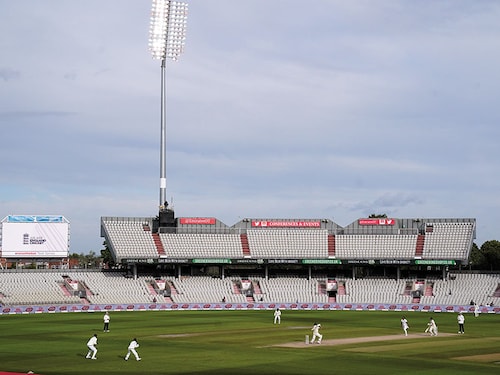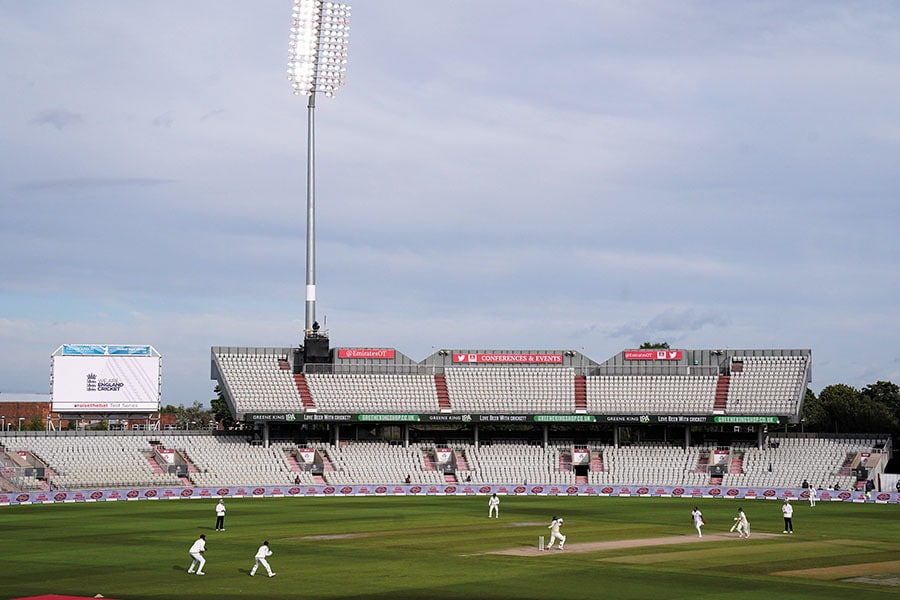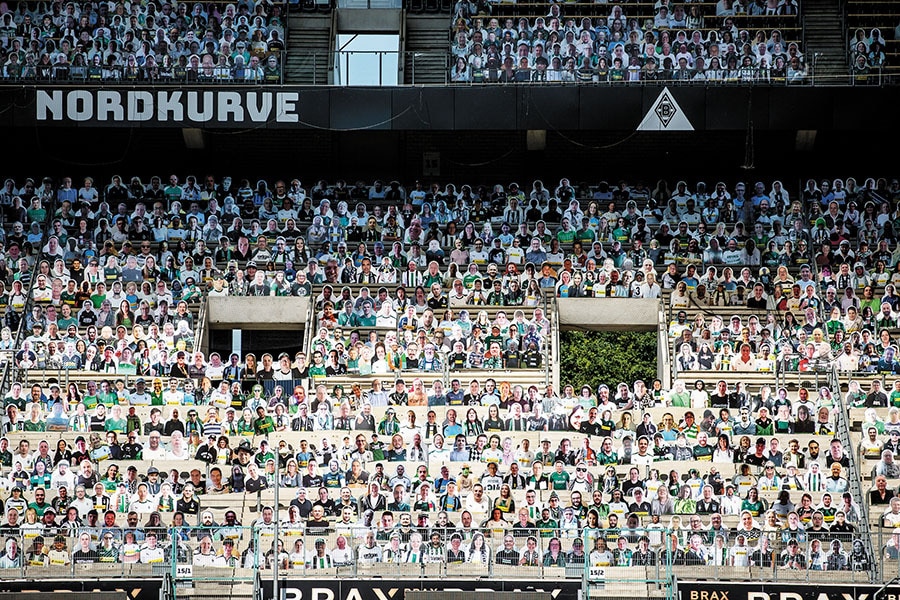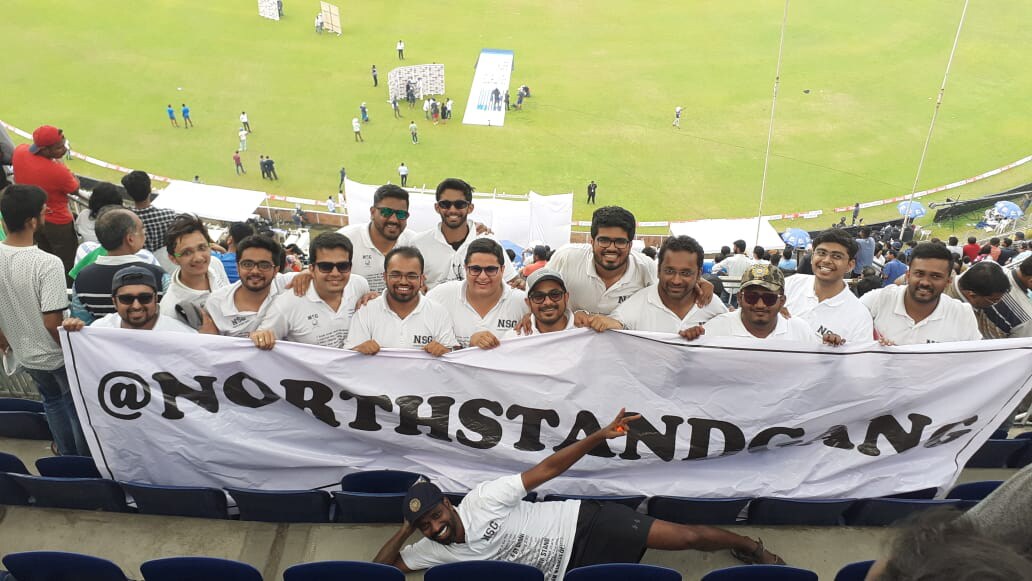Sports without spectators: Players adapt to new normal
As international sport resumes behind closed doors, players miss fans and vice-versa. But everyone is ready to roll with the new normal


 The Test series between England and West Indies in July, played in empty stadiums, marked the return of international cricket
The Test series between England and West Indies in July, played in empty stadiums, marked the return of international cricket
Image: Jon Super / Pool via Reuters
Among the many incredible legacies of WG Grace, one of cricket’s earliest celebrities, is a lore that doesn’t get old even with a century of retellings: Once given out lbw in an exhibition game, he just continued batting, reportedly telling the umpire off, “They came to watch me bat, not you umpire”.
Grace’s quirks may have hit the laws of the game for a six, but in his own way the bearded doctor from Bristol acknowledged an integral element of the sporting experience: The fans. As every sport aficionado would concede, a packed stadium and an involved crowd adds to the story and drama of a sporting contest. Consider that the 1986 soccer world cup is talked about as much for the emergence of Diego Maradona as an all-time great as it is for the Mexican Wave—a celebratory throwing up of hands in unison that was started earlier in the US, but introduced to the world at the tournament held in Mexico.
And players have indulged too. German tennis great Steffi Graf played along when a spectator threw her a marriage proposal in the middle of a match during Wimbledon in 1996. “How much money do you have?” the otherwise shy and reticent Graf replied, leaving the entire stadium in splits.
As international sport resumes after a Covid-19-induced hiatus, the new normal of playing behind closed doors has shut the fans out of the stadiums. And the loss has been a two-way street—as much for the fans who’ll miss the live action as it is for the players who yearn for the spurring-on from the stands. Ask English football club Liverpool, which played in deafening silence as they took the field after winning their first league title in 30 years.
“It won’t be wrong to say many results have gone our way because of the energy and support our fans bring in. Of course human safety is paramount, but I have to say we’ll miss the fans,” says Sunil Chhetri, captain of the Indian football team. Chhetri’s connect with fans came forth in 2018, when he put out a passionate appeal on social media goading them to come to the grounds to watch the national team play. “Abuse us, criticise us, but please come to watch,” he had written. As the 35-year-old gears up to play in the Indian Super League beginning November, in empty stadiums, he admits he did feel “a little weird” watching the vacant stands at the soccer leagues that have resumed in Europe.
Chhetri’s apprehensions have been confirmed by a report in the New York Times, with results drawn from data scoured from the Bundesliga, the first major sports league to return to the field following the pandemic. All home teams in the German domestic circuit have fared poorer than pre-Covid-19 games, with their win rates slipping by 10 percentage points to 33 percent. Besides, home teams have scored fewer goals than they had in full stadiums, taken fewer shots, won fewer corners and attempted fewer crosses and dribbles. The numbers have confirmed what a packed house has always been referred to in the sporting lexicon: The 12th man.
 The official kit of the Whistle Podu Army, the fan club of Chennai Super Kings, now includes a blue and a yellow mask
The official kit of the Whistle Podu Army, the fan club of Chennai Super Kings, now includes a blue and a yellow mask
In terms of business, clubs will feel the pinch next season, especially when it comes to match-day revenues. LaLiga, the Spanish domestic football league, is hoping for at least a partial attendance of spectators at the grounds when the new season begins on September 12. But if it doesn’t happen, bigger clubs will be affected in particular. “It’s not the same for, say, SD Eibar, which can host around 7,000 people compared to Barcelona, which has a seating capacity of nearly 100,000,” says Jose Antonio Cachaza, the India MD for LaLiga. “On top of that, museum tours and merchandise sales for bigger clubs like Barcelona and Real Madrid won’t be the same until we go back to the real normal, not this new normal. Our chairman reckons we would probably need two to three years to go back to where we were before March.”
Most Indian clubs are still waiting to hear from the game’s nodal authorities to work out the financial implications. Bengaluru FC’s CEO Mandar Tamhane conceded they earn about 3 to 4 percent of the revenues from ticketing and, in terms of merchandise, they are still selling online, “but it’d be tougher than the sales we would have had if fans came to watch our games”.
Not just players and clubs, broadcasters, too, need spectators as much. “Let me take you back to 2011, to India winning the cricket world cup final,” says Bryan Henderson, head of cricket, Sky Sports, which broadcast the July Test series between England and West Indies, played in empty stadiums. “As MS Dhoni launches into the final hit 30 rows back into the stands, imagine that frame without shots of the crowd going berserk. Live sports and spectators are inextricably intertwined.”
Often, commentators and broadcasters embrace such frenzy in a way that embellishes their craft. Cricket enthusiasts still recall how former Kiwi international Ian Smith, now a commentator, called the dying stages of the world cup final in 2019, a match that his country lost by the skin of its teeth. In the commentary box, Smith choked, gasped, held his head in his palms and bobbed up and down as he summed up the closing moments: “England has won the world cup by the barest of all margins. Absolute ecstasy for England... agony for New Zealand.”
“Using the emotions of the crowd is an art,” says Alan Wilkins, a Welsh broadcaster for 36 years. “Ian was not just reacting to the contest unfolding in front of him, but also to the emotional waves of noise emanating from the full house at Lord’s.” Wilkins, who has been part of cricket, rugby, tennis and golf broadcasts, calls the Wales vs England rugby coverage at Cardiff’s Principality Stadium among the most emotional of his career, wrought by the national anthem sung out by a 75,000-strong crowd.
 In Germany fans were invited to put their cardboard cut-outs in the stadium
In Germany fans were invited to put their cardboard cut-outs in the stadium
Nasser Hussain, a former England cricket captain and now a commentator with Sky Sports, on the other hand, prefers it quiet when he’s commentating. Which made it easier for him to adapt to the echoing silence at the Ageas Bowl (Southampton) and Old Trafford (Manchester), where the three Test matches between England and West Indies were played. “Usually, I will just have the producer, the director and the stats guy in my ear,” he says. “But the other day when Ben Stokes was walking off the ground in Manchester [in the second Test] after a magnificent 176, it hit me for the first time that wouldn’t it have been great around the world to see the whole of Old Trafford rise to Stokes? And for Ben himself, it’s a little soul-destroying to go off with no one watching or clapping, apart from his teammates.”
In a non-Covid-19 universe, present in those stands would be a raucous gang of the Barmy Army, a club of travelling English cricket fans that started with 30-odd backpackers for the Ashes tour of 1994/95 and has now snowballed into 36,000 members. “Gutted” is how Chris Millard, its managing director, feels as he watches the matches from his home in Sheffield, unable to “sing the lads on”. The Army, which also operates the travel company Barmy Travels, has seen a huge dip in bookings for future tours with uncertainty over travel. England is scheduled to tour India in January, but realistically, Barmy Army is looking to travel only to the next Ashes tour of Australia in November 2021.
The inability to gather has halted the growth of fan groups across the world, says Sagar Walve, a doctor and a member of the North Stand Gang-Wankhede (NSG-W) from Mumbai. Birthed, ironically, at the Brabourne Stadium, Wankhede’s neighbour, during India’s Test match against Sri Lanka in 2009, NSG-W has seen members multiply with each visit to the stadium as they co-opt other zealous fans seated in the vicinity. “We grow due to our presence in the stadiums. Besides, we come from different professional and socio-cultural backgrounds, but when we enter the stadium, we hold only one identity. That is something we’ll miss if the matches are held without fans,” says Walve.
 Members of the Barmy Army, a travelling fan club for the English cricket team, are trying to recreate a ground-like atmosphere in their drawing rooms
Members of the Barmy Army, a travelling fan club for the English cricket team, are trying to recreate a ground-like atmosphere in their drawing rooms
Despite their disappointments, both the Barmy Army and the NSG-W are convinced that the show must go on. “At a time we all needed something to get behind, we are delighted the boys are back on the field,” says Millard. To recreate the stadium atmosphere in their drawing rooms every morning, after the first ball is bowled, the Barmy Army trumpeter appears live on their Facebook page with his rendition of William Blake’s ‘Jerusalem’, the rousing English anthem the Army also reposts home-bound celebrations of fans to give them a community vibe, earlier derived from the pre- and post-match pub hangouts. NSG-W, on the other hand, has picked up chatter on Twitter, commemorating birthdays, dishing out trivia and reminiscing about old matches, among other things. “Even if cricket doesn’t start in India for six more months, we would have enough to talk about for the rest of our lives,” says Abhishek Chopra, an HR professional and a cricket fanatic.
Ingo Muller, a fan of Borussia Monchengladbach, a German club that’s now ranked fourth in the Bundesliga, went a step ahead and invited fans to put their cardboard cut-outs in the stadiums for the home games. Muller came up with the idea along with his wife while the two were home-quarantining in March fearing possible exposure. “Initially, we expected 500 or at best a thousand responses, but never 20,000,” says the 52-year-old over a call from Berlin.
Muller charged every applicant 19 euros, 19 being the talismanic number as the club was founded in 1900 the production costs came up to 12.50 euros, while the rest of the money, a corpus of 80,000 euros collected by early July, was donated for charity. Not just fans, but the players too—German international Matthias Ginter, and club and Swiss national goalie Yann Sommer—put up cut-outs of family and friends. “Not going to the stadium is horrible. But restarting the league was a good example for the sporting community,” adds Muller.
 The North Stand Gang-Wankhede, a group of cricket fans from Mumbai, has amped up engagement on Twitter and says it has enough conversation themes to keep going for a lifetime
The North Stand Gang-Wankhede, a group of cricket fans from Mumbai, has amped up engagement on Twitter and says it has enough conversation themes to keep going for a lifetime
Image: North Stand Gang-WankhedeCloser home, while the IPL franchises are working out the modalities for the tournament to be held in the UAE, fans have amped up engagement. The Whistle Podu Army, the official fan club of the Chennai Super Kings, is preparing to send out its kit, after a delay of four months, comprising a T-shirt, a membership card, a flag and, to keep with the times, yellow and blue masks. “And we are all waiting to see MS Dhoni back in action,” says Prabhu Damodaran, the leader of the pack and a textile professional in Coimbatore who travels 500 km overnight for every CSK home match. Rajasthan Royals, on the other hand, has launched Super Royals, a 20-member exclusive group that will be in charge of building the “largest fan army”. “The idea of a Super Royals community was inspired by the creative and insightful content they shared on social media. We want to reach out to a larger community through them and ensure they play an important role in engaging the Royals family,” says Jake Lush McCrum, team COO.
The resumption of sports isn’t just good news for drooping morale, but for business as well, salvaging whatever is left of it through broadcast rights and sponsorships. For LaLiga, most of the broadcast agreements have been long-term, and the league hasn’t seen any cancellations yet. “In fact, we have closed some negotiations with an increase in revenue for next season,” says Cachaza, India MD.
To set the ball rolling, the league has had to take drastic measures—like limiting the number of journalists, “our window to the fans”—that left no one happy. Even the 100-strong broadcast crew for the England-West Indies cricket series was tested four days before being allowed into the bio-bubble, given special accreditations for specific zones, and put up at one of the two designated hotels. Hussain missed his morning chat on the outfield with former mate and England’s batting coach Graham Thorpe as players and broadcasters were put into separate bubbles. “The other day I was walking across to the ground at Old Trafford, something I have done for 20 years, and I was told, ‘Sorry, you can’t do that’,” he says.
Initial jitters notwithstanding, it’s been all good since. “I thought a few months ago we were putting a lot of work into something that was not going to be very watchable,” says Henderson of Sky Sports. “What has surprised me though is how enjoyable televised coverage of sports has been even without the crowds.” Since the lockdown, Sky’s coverage of the Premier League has seen an uptick of 30 percent in viewership the cricket numbers aren’t in yet, but the network has received Twitter feedback from around the world.
The LaLiga telecast on Facebook, the official home for the matches in the Indian subcontinent, saw a 73 percent rise in audience. The absence of live sports triggered a glut that doubled or even tripled viewers for matches that featured Barcelona or Real Madrid. “In mid-July, we broke the Facebook record for polling three times in a single week. The number of comments has gone up five-fold since the lockdown ended in Spain,” says Joe Morrison, a presenter at Facebook Watch for LaLiga. Even Chhetri admits to engaging with fans much more than ever.
Empty stands have also been the breeding ground for innovative broadcasting ideas. Sky Sports has introduced a buggy cam, or a remote-controlled system, that covers the coin toss and the post-toss interviews with the two captains. Besides, an aerial camera was deployed to broadcast unique angles from stands that would earlier be filled. The crew has set up a marquee at the back of the dressing room for remote player interviews before, after, and during matches, a feature that Henderson believes can be carried into the post-Covid-19 era as well.
“But the most important learning,” says Henderson, “has been the embedded spectator noise, called ‘the Lord’s hum’—the fake audio loop picked up from an old Test at Lord’s. That it has not been spoken about much probably means it has worked. We need to create more bespoke chants—like a collective gasp for a dropped catch—for ODIs and T20s. But I really hope fans will be back in the next season before we get to work on that.”
First Published: Jul 28, 2020, 11:37
Subscribe Now